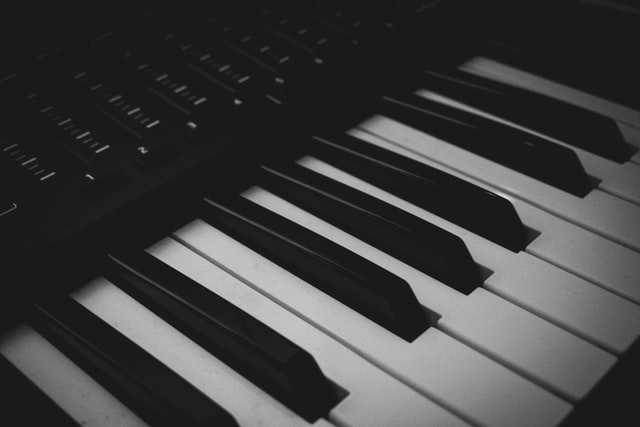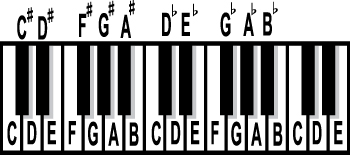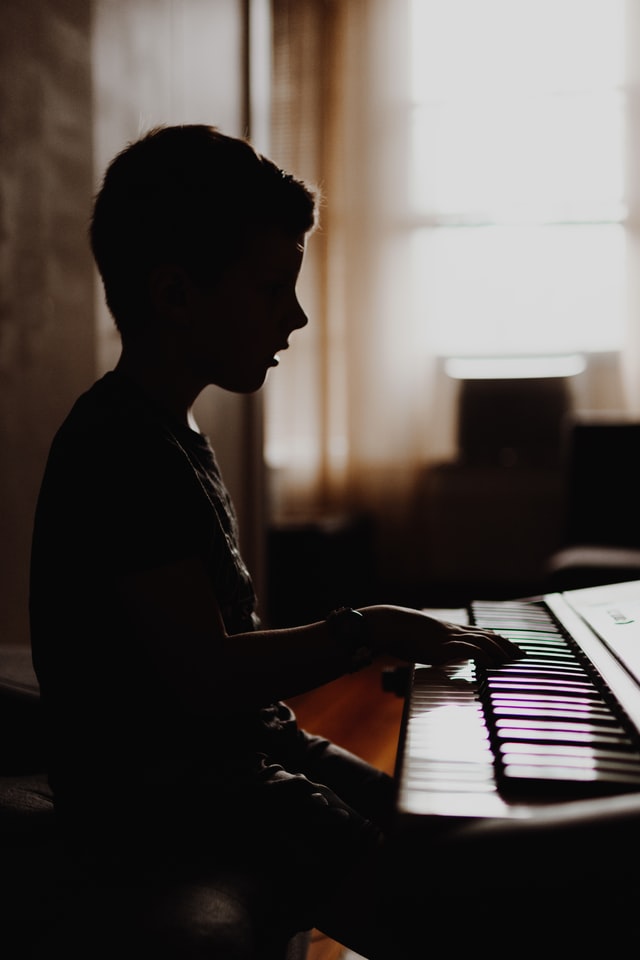Piano notes for kids. This is one of the building blocks of piano knowledge for anyone who is learning, and children can sometimes struggle with learning the notes. It is hard for an adult, so how do we approach piano notes for kids in a way that makes it simple and easy to retail the knowledge?
In this guide, we’re looking at the process of teaching piano notes for kids and working out exactly how they can remember the key names. We will look mainly at the notes themselves for people who are learning by ear, but we also take a quick look at the musical staff and how the notes can be established looking at this.
Piano Notes for Kids – Can I Use Stickers?
This is one of the great debates when learning how to play the piano. Using stickers is popular among beginners, and is a way to label all of the notes so you don’t have to spend all of your time working things out. It does make it easier to start with, there’s no denying that. You will be able to play your first melodies on the piano much more quickly and easily if you use stickers to mark out the notes.
However, there is a downside. At some point, those stickers are going to need to go. If you haven’t taken the time to memorize where on the keyboard different notes are then it can be a bit like going back to square one.
Think of them like stabilizers for your bike. They are great for learning and building up a little confidence, but they also stop you from learning the most important aspects of riding a bike; learning not to fall off!
So, stickers are ultimately a matter of preference. We have created a full guide to whether or not stickers are a good idea in this blog post. Of course, you don’t have to use actual stickers and if you are using a cheaper keyboard you might even use an erasable pen to mark out the notes. Just don’t do this on your beautiful new Steinway piano!
Understanding Octaves
When teaching piano notes for kids it can help to take a little bit of the intimidation away if you are able to explain to them about octaves.
If you look at a full piano then you will notice 88 keys staring back at you. If you feel like you have to learn every single one of them separately then it can be quite a scary concept. Luckily, the piano is one big pattern, which repeats. Each “repetition” is called an octave.
Once you have learned the notes within an octave then you know the notes all the way up and down a piano!
The octaves are simply higher or lower than one another in pitch, but you are still playing the same note. In the diagram above, you will notice at least two of every note. In fact there are 3 “C”s. A good way to teach piano notes for kids is to explain these as being higher and lower than one another. Get them to play the “middle C” and then the C above it and the C below it. Everything between those notes will then start to fall into place.
So, as the diagram shows you, there aren’t too many notes to actually learn once you break it down into these little octave chunks. When learning piano notes for kids, it can be really intimidating, so the important thing is to focus on one small area of the keyboard. Knowing that it repeats can stop children from panicking about having to memorize this whole alien keyboard!
Tricks to Know Where You Are
Finding your place on the keyboard is one of the most important things you need to learn at the start of your piano journey. Eventually, it will become like second nature to you. If you have learned to drive, think of how difficult this was at the start and how eventually it all just became the simplest thing in the world!
Let’s take another look at the pattern, and how it relates to the notes. Just focus on the white notes to start with, as the black notes will be added later on when we fully understand them (these are sharps and flats).
In the diagram above you have a full list of the notes as well as just being able to see the keys. There are some tricks that specifically help with piano notes for kids. They make it a bit of fun as well as just making it simple to find your way around the keyboard.
All of the patterns rely on you establishing the black notes, which come in clusters along the keyboard. There are 3, then 2, then 3, then 2.
Each of the methods of learning the keys relies on you having one note that you use to anchor yourself on the keyboard. Adults might just be able to memorize this easily. For example, if I say to you that the key to the left of the cluster of two black notes is a C, it might be easy enough to commit this to memory.
For kids, something a bit more fun might be in order…
The “Dog House” Method
This method is so effective for children. Piano notes for kids is quite a dry and boring subject so by adding a bit of humor and fun, you can make it feel a bit less of a chore.
The video above explains it pretty well. When teaching youngsters I always tell them to think of the two black notes as a doghouse. If you really use your imagination, you can just see a little dog poking out. “D” stands for “Dog” so we know we are at the D note!
This is a way to always be able to find where you are on the keyboard.
The “Dracula Fangs” Method
The same thought process applies here, again, it relates to the patterns of 2 and 3 black notes along the keyboard.
How many fangs does Dracula have? 2! So, wherever we find the 2 notes together, we can assume that these “Dracula Fangs” has a D sitting right in the middle.
Whatever you find easiest to learn is fine. Children can find a lot of these suggestions to be a bit of a laugh and while you are learning the very basics of the piano and the notes of the keyboard this can be much needed.
What Now?
So, you have your anchor on the keyboard. You know that whatever happens you can find either the D or the C note and work from there.
Playing the piano, or at least the very basics of piano, can boil down to a few simple basic rules. Once you remember these rules then you are ready to learn more about the piano and start to take onboard chords and other building blocks of piano knowledge. Children and rules often don’t mix, however!
Learning your ABCs is a really vital thing to do when learning the piano. As adults, and even once children get to school age, you expect them to have this knowledge pegged, but actually there might be a few gaps in the knowledge of the alphabet. Luckily, the piano only uses A to G as a way to establish where you are on the keyboard. There is no “H” note. Once we get to G, we simply go back to the start and play A again, but an octave higher. This is how all of the patterns link up.
As long as your kid can sing “A, B, C, D, E, F, G” then they should be able to get to the next level of piano knowledge. Luckily, if we ignore the black notes for now, the notes are in alphabetical order. Even things in piano that look complex initially are quite simple when broken down into manageable chunks of information.
Another look at the notes of the piano is useful here. Notice how A, B, C, D, E, F, and G repeat along the keyboard. This is something to point out to children. Having to learn seven notes is a lot less intimidating than thinking there are 88 different notes to get to grips with.
How to Practice
For kids there are a couple of ways to practice this knowledge and try to ensure that it has well and truly stuck within their brains.
The first way is just to ask them to play a note at random. Ensure there are no stickers or other guidelines. This will force children to think it through logically.
Let’s say you ask a child to play an “F” note. The thought process for finding piano notes for kids usually goes something like this:
- Find “D” on the keyboard. I know this because of Dracula fangs!
- Count up to an F…D, E, F…
- Play the F note! I find D, skip the E note and then play the F!
It couldn’t be much more simple. When you start to ask a child to play notes like “A” and “B”, it might be interesting to note their technique. Some will start at D and count down, others will count up, get to G and then cycle back through. Either are legitimate ways to find the notes, but if your child goes the “long way” to find the notes then you might explain to them that counting backwards can be equally effective and a quicker way to get to the notes that come before D in the alphabet.
Eventually, this knowledge will start to become second nature. They will know which note they are at just by a glance at the keyboard.
Making practice a little more of a challenge can be turned into a game. We love to “gamify” piano! When you are teaching children then this can undeniably be one of the most effective ways to get through to them. If they don’t feel like it is a lesson so much they are much more likely to stick with it.
Games to Learn the Notes of The Piano
So, what are some games you can play with kids as they learn the notes of the piano? How can you turn it into more of a fun and memorable activity rather than just asking children to commit the keyboard to memory.
Note: Some of these games are much more fun if done competitively. If you can add an element of time into it, such as using a stopwatch, or you can have more than one child trying to play the game at the same time, it becomes much more enjoyable.
The Spelling Game
There are plenty of words that can be made by combining the first seven letters of the alphabet. The aim of this game is to get your child to quickly spell out the word using the keyboard.
You shout out a word, and they have to spell it out using their keyboard or piano.
Obviously, you can use any word that comprises only of A, B, C, D, E, F, G
Some of the words you can use for this game include:
- Beg
- Bed
- Bad
- Add
- Faded
- Dab
- Fab
- Bee
- Beef
- Dad
- Feed
- Cab
- Bag
- Ace
- Face
- Bead
- You get the idea…
Introducing an element of competition and speed makes it fun but also encourages children to think on their feet and quickly get to the end result. This sort of quick thinking isn’t just for the sake of it, it is the exact skill required when it comes to playing the piano.
The Animal Game
Another simple game that can be a lot of fun when made competitive.
Simply call out the name of an animal that starts with one of the letters. By conjuring the image of that animal in the child’s head, you are adding an extra task for them as they work out the first letter and then play the corresponding note on the keyboard.
Dog, Cat, Elephant, Frog, Goose, Duck, there are loads.
Once your kid starts to find this game a bit easy, you can make it more difficult by getting them to use the last letter of the word. You can introduce more animals this way, too! For instance, “Pig” would lead to your kid playing the “G” note to get a point!
Remember that learning the names of piano notes for kids is not the easiest thing in the world. It’s actually quite frustrating for youngsters if there is no element of fun or reward involved. Adding some cool little games like this keeps it fresh.
Notes of The Staff
This is the other aspect of learning piano notes for kids. If they are going to learn how to read music then kids need to know where the notes are on the piano but also exactly how they look on sheet music, on the musical staff.
This graphic shows the notes on the line, and the notes in between the line, on the treble clef musical staff.
You can see that the notes in between the lines are pretty easy to remember. You simply have to remember F A C E. I love it when it spells a word so that you don’t have to come up with a little game to remember these things.
The notes on the lines aren’t quite as simple, but you can remember them with a simple little saying. Different people use different sayings, but one we like is “every good boy deserves football”.
There are many ways to remember these notes, so it isn’t too much of a challenge. The difficult thing is putting it into practice when the notes are written in sheet music and rearranged in the order they are played within a song.
Perseverance is needed whether you are a young kid or an adult learning how to play the piano, so it can be a real challenge at this point. Some people don’t learn how to read music at all. Playing by ear is becoming more and more popular. Gone are the days where we couldn’t always hear a piece of music before trying to play it ourselves, so arguably, there is less need for sheet music. It’s still very useful, and if you want to be a classical pianist you are going to have to learn this skill.
Sharps and Flats
We’ve ignored the black notes on the keyboard long enough. These notes are really important to understand, too, but it helps if you learn the white notes first as frame of reference.
Every note can be turned into both a sharp or a flat version. Sounds simple enough. These are a half-step up or down from the original.
For example, if we take D, the black note to the right is the D# (sharp). The black note immediately to the left is a D flat or Db.
The following video does a good job of explaining how this works:
You might then find that things start to get a bit confusing.
On the diagram here, we have the sharps and the flats shown on two different octaves. Notice that the same note can be the sharp for one note and the flat or another. For example, D# and Eb are the same note.
Whether it is referred to as a sharp or a flat depends on what scale the song you are playing is in. Don’t worry your kids with this knowledge to get started. It’s just important to know that sharps and flats can share a note on the keyboard. Whether you ask them to play Gb or F# you are asking for the same thing.
The theory behind this section of playing the piano can get a little bit confusing. Even more so when we look at a note like C. C does not have a flat. Technically, a half-step down here leads you to play the B. The B note is the same as a C flat, but you won’t usually hear it referred to as Cb, you will just hear it referred to as B.
This post explains in a little more detail.
You can probably see now why we decide to teach the white notes first. It is less confusing and therefore makes a better starting point when building the foundations of music knowledge. Sharps and flats aren’t too hard to get your head around once you’ve been playing a while. It isn’t rocket science, but it is harder than the straightforward A-G of the white notes.
Should I Teach Piano Notes for Kids Before Songs?
A child learning to play is going to have to have some knowledge of notes before they learn how to play a song. It is the very language that piano is explained in, so you can’t really learn a song without knowing at least how to find the notes.
However, learning songs before you have a complete grasp of all the notes is a good way to cement this knowledge and become a bit more confident in finding the notes. A child will have to establish which note is next, and this can lead to them looking at the musical staff and having to learn the note or just establish where it is on the keyboard itself.
Conclusion
As vital building blocks of piano knowledge go, this is one of the most imperative you can possibly come across. Everyone needs to know piano notes. A few of the ways of teaching piano notes for kids try to make things a bit more fun and interesting rather than just hoping that a child takes in the knowledge. This way, your child is less likely to want to give up after a few lessons.
Every child learns at a different pace and different things will click better for different children. The key is to keep persevering and trying new things to engage your child, and learn the notes of the piano before trying to take on anything too complex.













